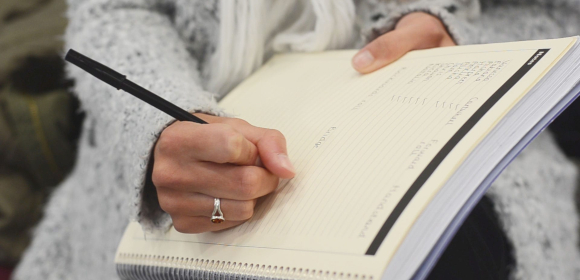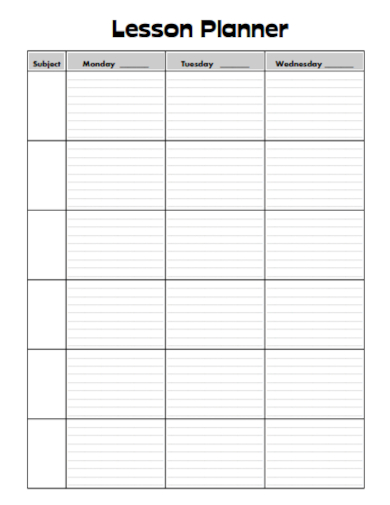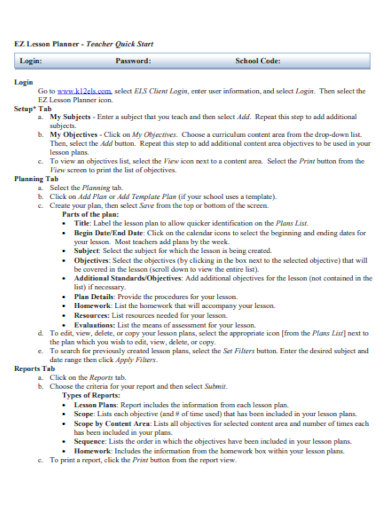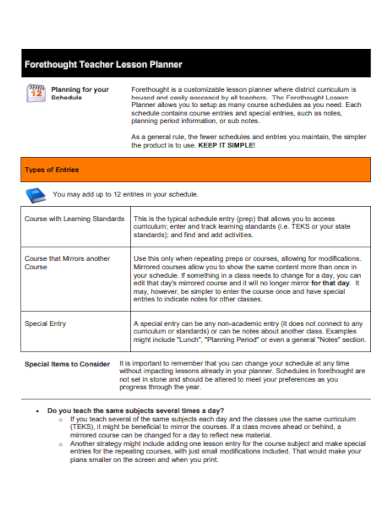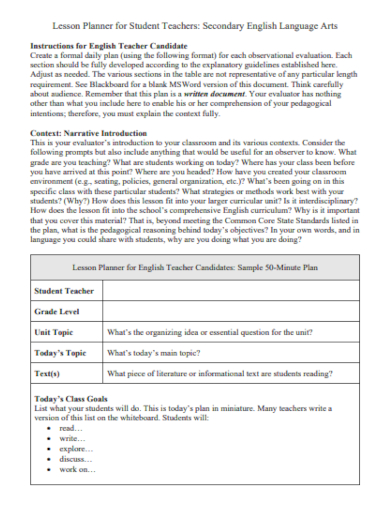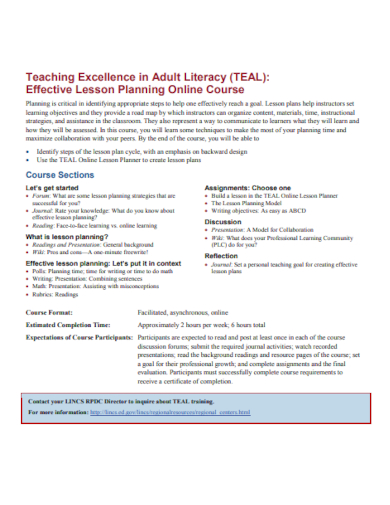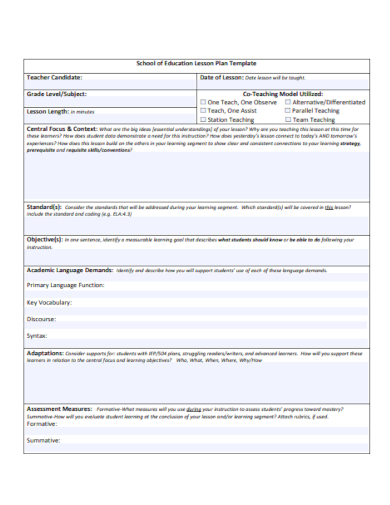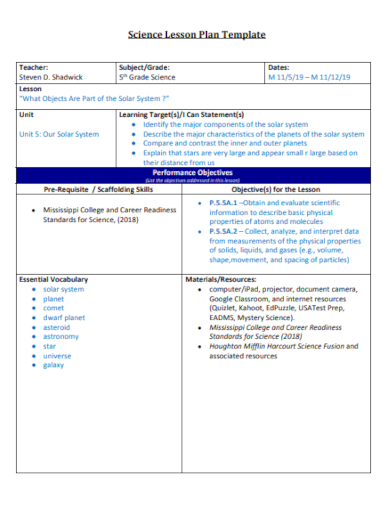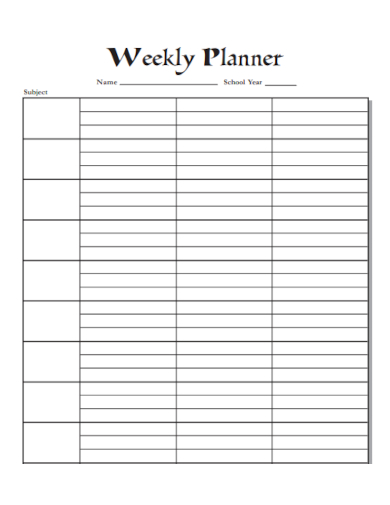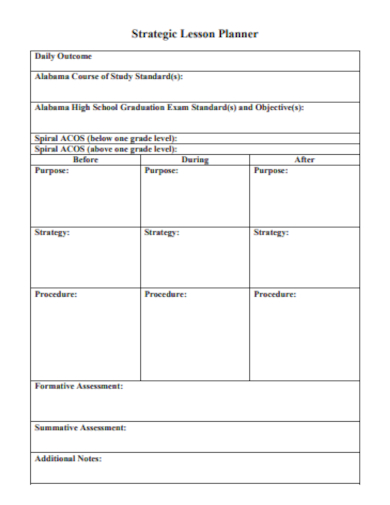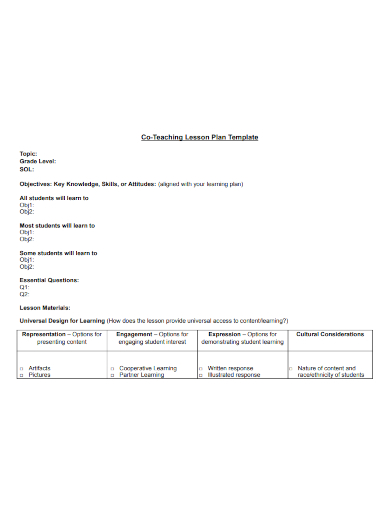The action that a teacher engages in before the beginning of a class is known as “lesson planning.” The significance of a teacher’s lesson planner lies in the fact that it allows the teacher to read ahead to gain valuable content area and skill that is to be taught. Besides, a simple lesson planner helps the educator have confidence while the actual teaching and learning process is taking place and logically introduces the content standards to facilitate effective learning. It is valuable for any substitute teacher, such as the elementary teachers, the preschool teachers, and any subjects like Physical Education, Math, English, etc.
FREE 10+ Teachers Lesson Planner Samples
1. Teacher Lesson Planner Template
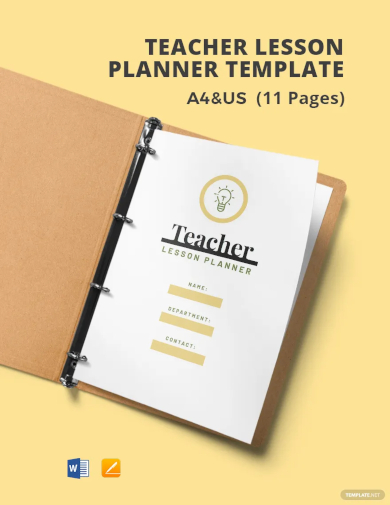
2. Teachers Worksheet Lesson Planner
3. School Teachers Lesson Planner
4. Sample Teachers Lesson Planner
5. Lesson Planner for Student Teachers
6. Teachers Online Lesson Planner
7. Teachers Education Lesson Planner
8. Science Teachers Lesson Planner
9. Teachers Weekly Lesson Planner
10. Teachers Strategic Lesson Planner
11. Co-Teachers Lesson Planner
What Is a Teacher’s Lesson Planner?
A teacher’s lesson planner is a road map that teachers develop to organize everyday and weekly lesson activities in their classes. It describes what the students will learn during each period of their university lesson as well, how the lesson will be taught, and how the progress of the students will be evaluated. A lesson plan is often a document around one or two pages long, divided into various sections that define what will occur during each day. Aside from that, it can be used for a teacher’s yearly lesson or daycare lesson activities.
How To Make a Teacher’s Lesson Planner?
In every one of your classes, there will be portions of the content that you will not be able to anticipate. On the other hand, if you are properly prepared, it will be much easier for you to adapt to unanticipated circumstances and respond in a manner acceptable to your students. Because of this, you will be able to educate more successfully. Some of the steps involved in constructing a basic lesson plan are outlined in the following paragraphs.
1. Specify Objectives
Before moving on to arranging the class, you must first ascertain what your goals for the students’ education are going to be throughout this session. When developing a lesson plan for physical education, for example, the focus of learning objectives should not be on what the student will be taught during the course of instruction, but rather on what the student will be able to do.
2. Plan The Activities
When planning learning activities, you should consider the many different types of tasks that students will need to engage in to acquire the skills and knowledge they require to show that they have successfully learned the material presented in the course. This is especially important when planning activities for higher education classes.
3. Plan The Assessment
Assessments such as examinations, essays, problem sets, and presentations allow students to exhibit and practice the information and abilities outlined in the learning objectives. At the same time, teachers are given a chance to provide students with focused feedback that can serve as a guide for students as they continue their education.
4. Showcase New Content
Make use of various teaching methods, such as the more commonplace lectures, readings, activities, projects, multimedia, and others. To keep against having too much information flood your mind, arrange the information in a logical order and then break it up into smaller bits. If you combine the facts, it will be much simpler for you to remember the information in the future.
What exactly is the point of creating lesson plans?
A lesson plan is a guide that an instructor uses every day to establish what the students will learn, how the lesson will be presented, and how the learning will be evaluated.
What are some of the benefits associated with lesson planning?
Lesson plans have a number of benefits, including the ability to inspire, evaluate, and build students’ self-confidence.
What are the fundamentals of putting together a lesson plan?
The three principles are as follows: (a) beginning the process of lesson planning by defining a clear LO; (b) constructing learning opportunities that lead to accomplishing the LO, and (c) including a suitable formative assessment that provides tangible evidence of having achieved the LO.
It is essential to comprehensively understand a lesson’s meaning before attempting to comprehend the nature of a lesson plan. A single action or a series of activities prepared by the instructor in such a way as to achieve one or more educational objectives defined, or desired, in the process of encouraging positive change in the learner is referred to as a lesson.
Related Posts
FREE 10+ Meeting Planner Samples in PDF
FREE 10+ Course Planner Samples in PDF
FREE 8+ Calendar Planner Samples in PDF
FREE 10+ Cute Workout Planner Samples in PDF | MS Word | Apple Pages
FREE 10+ Financial Planner Samples in PDF | MS Word | Apple Pages
FREE 10+ Digital Planner Samples in PDF | Apple Pages | MS Word
FREE 7+ Year Life Plan Samples in PDF
FREE 6+ 7 Day Weekly Planner Samples in PDF
FREE 50+ Project Planner Samples in PDF | MS Word
FREE 50+ Planner Samples in PDF | MS Word
FREE 10+ Menu Planner Samples in PDF
FREE 10+ Training Planner Samples in PDF
FREE 6+ Bill Planner Samples in PDF
FREE 8+ Birthday Planner Samples in PDF
FREE 10+ Yearly Planner Samples in PDF | MS Word | Apple Pages
